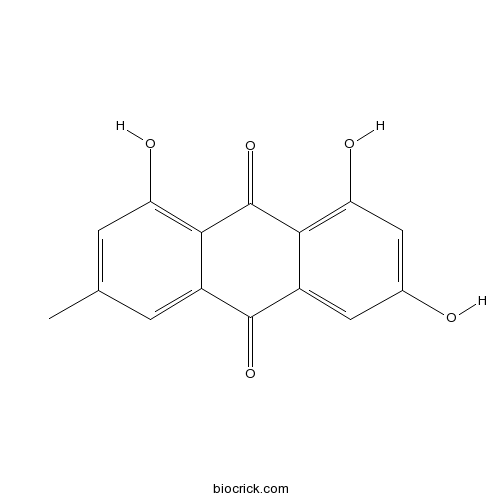Gnaphalium affine
Gnaphalium affine
1. The products in our compound library are selected from thousands of unique natural products; 2. It has the characteristics of diverse structure, diverse sources and wide coverage of activities; 3. Provide information on the activity of products from major journals, patents and research reports around the world, providing theoretical direction and research basis for further research and screening; 4. Free combination according to the type, source, target and disease of natural product; 5. The compound powder is placed in a covered tube and then discharged into a 10 x 10 cryostat; 6. Transport in ice pack or dry ice pack. Please store it at -20 °C as soon as possible after receiving the product, and use it as soon as possible after opening.
Natural products/compounds from Gnaphalium affine
- Cat.No. Product Name CAS Number COA
-
BCN5649
Emodin518-82-1
Instructions

-
BCN5658
Apigenin520-36-5
Instructions

-
BCN4171
Wogonin632-85-9
Instructions

-
BCN4327
Ursolic acid77-52-1
Instructions

Chemical constituents from Gnaphalium affine and their xanthine oxidase inhibitory activity.[Pubmed: 29860995]
None
Luteolin-4'-O-glucoside and its aglycone, two major flavones of Gnaphalium affine D. Don, resist hyperuricemia and acute gouty arthritis activity in animal models.[Pubmed: 29519319]
Gnaphalium affine D. Don is a folk medicine of China believed to be efficacious in the treatment of many ailments, including hyperuricemia and gout.
The Anti-inflammatory Effect of Gnaphalium affine Through Inhibition of NF-κB and MAPK in Lipopolysaccharide-Stimulated RAW264.7 Cells and Analysis of Its Phytochemical Components.[Pubmed: 27324043]
Gnaphalium affine is an annual herbaceous plant that is used as a traditional medicine in some Latin American and Asian countries. However, systematic studies on its anti-inflammatory activity and signaling pathways have not yet been reported. In this study, we investigated the anti-inflammatory effect of G. affine methanol extract in lipopolysaccharide (LPS)-stimulated RAW 264.7 murine macrophage cells and fractioned the methanol extract into hexane, chloroform, ethyl acetate (EtOAc), butyl alcohol (BuOH), and distilled water (DW) by measuring the generation of nitric oxide (NO). G. affine inhibited the generation of NO and prostaglandin E2. The chloroform-soluble fraction most effectively inhibited LPS-stimulated NO production. We also examined the cytotoxicity of G. affine in three normal cell lines: RAW264.7, HEK293, and HaCaT. Cell viability assays showed that the methanol extract and chloroform-soluble fraction of G. affine had no cytotoxic effect on normal cell lines. The expression of pro-inflammatory mediators was also investigated. Western blotting and immunofluorescence showed that G. affine reduces the expression of iNOS, COX-2, and MAPKs, as well as activation of NF-κB in LPS-stimulated RAW264.7 cells. RT-PCR showed that G. affine also negatively regulates inflammatory cytokines at the gene expression level. Taken together, G. affine exerts its anti-inflammatory activity through inhibition of NO generation as a result of inhibiting NF-κB and MAPKs-related inflammatory signaling pathways. In addition, the result of GC-MS analysis revealed the presence of nineteen different types of constituents including guaiacol in the chloroform-soluble fraction of G. affine.
Anti-inflammatory effects of the extract of Gnaphalium affine D. Don in vivo and in vitro.[Pubmed: 26561928]
Gnaphalium affine D. Don (GA) has been traditionally used as a medicinal herb in China for the treatment of many ailments including rheumatoid arthritis. However, the anti-arthritic mechanism of GA has still not been demonstrated. This study aims to reveal the anti-inflammatory activity and anti-arthritic mechanism of ethanol extract of G. affine D. Don.
Inhibition of xanthine oxidase activity by gnaphalium affine extract.[Pubmed: 25429747]
To evaluate the inhibitory effect of Gnaphalium affine extracts on xanthine oxidase (XO) activity in vitro and to analyze the mechanism of this effect.
Cadmium accumulation characteristics of the winter farmland weeds Cardamine hirsuta Linn. and Gnaphalium affine D. Don.[Pubmed: 24519638]
In a preliminary study, we found that the cadmium (Cd) concentrations in shoots of the winter farmland weeds Cardamine hirsuta Linn. and Gnaphalium affine D. Don exceeded the critical value of a Cd-hyperaccumulator (100 mg kg(-1)), indicating that these two farmland weeds might be Cd-hyperaccumulators. In this study, we grew these species in soil containing various concentrations of Cd to further evaluate their Cd accumulation characteristics. The biomasses of C. hirsuta and G. affine decreased with increasing Cd concentrations in the soil, while the root/shoot ratio and the Cd concentrations in shoot tissues increased. The Cd concentrations in shoots of C. hirsuta and G. affine reached 121.96 and 143.91 mg kg(-1), respectively, at the soil Cd concentration of 50 mg kg(-1). Both of these concentrations exceeded the critical value of a Cd-hyperaccumulator (100 mg kg(-1)). The shoot bioconcentration factors of C. hirsuta and G. affine were greater than 1. The translocation factor of C. hirsuta was less than 1 and that of G. affine was greater than 1. These findings indicated that C. hirsuta is a Cd-accumulator and G. affine is Cd-hyperaccumulator. Both plants are distributed widely in the field, and they could be used to remediate Cd-contaminated farmland soil in winter.
The antioxidant activity and active component of Gnaphalium affine extract.[Pubmed: 23685244]
The antioxidant activity of Gnaphalium affine extract (GAE) against H2O2-induced oxidative injury in Caco-2 cells was evaluated, and the main antioxidant component was isolated and identified by column chromatography, high performance liquid chromatography, time-of-flight mass spectrometer and nuclear magnetic resonance. In vitro assays, GAE showed remarkable antioxidant activity to scavenge free radicals (ABTS, DPPH, superoxide and hydroxyl radicals), inhibit lipid peroxidation and show reducing power. In food system, GAE exhibited the obvious capacity to inhibit the oxidation of peanut oil and lard, which may be attributed to its high content of phenolic compounds. Moreover, GAE could effectively protect Caco-2 cell against H2O2-induced oxidative injury. With the isolation and purification by chromatography, quercetin was identified as the main antioxidant component of GAE, which was capable of scavenging ABTS, DPPH, superoxide and hydroxyl radicals. These results suggest that G. affine is a potential source for preparing functional foods and nutraceuticals in food industry.


